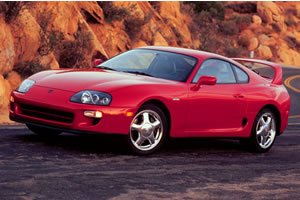


This edition of the Dodge Charger 5.7 V8 R/T is the 5 speed / Semi-Auto version and was first brought out in 2006. This was at around the same time as the introduction of the 2007 Caparo T1 3.5l V8 and the 2006 Caparo T1 2.4 V8.This particular Dodge Charger has a 5654cc Naturally Aspirated Petrol powerplant with 8 cylinders in a V formation.
The Charger shares its Petrol V8 engine configuration with the likes of the 2023 Dodge Challenger SRT Demon 170 and the 2023 Ferrari SF 90 XX Spider 4.0 V8 Turbo. If you're looking for other fast cars which share the Charger's Rear Wheel Drive, Coupe combination then how about the 1982 Fiat X1/9 1.5 8V or the 1965 Aston-Martin DB6 1965.
Weighing in at 1878 kgs (4140 lbs) this makes the Dodge Charger 5.7 V8 R/T in the same weight category as the 2022 Aston-Martin Vantage 5.2 V12 Twin Turbo Roadster or the give or take 50kg.
In terms of power the 5654cc 16V V8 engine produces 350 bhp (260 kW) @ 5000 rpm similar to the 2024 Mazda CX-90 S 3.3 Turbo (340 bhp) or the 2024 Chevrolet Corvette E-Ray 6.2 V8 Petrol Hybrid C8 (369 bhp).
The Naturally Aspirated V8 throws out 390 lb-ft (528.7 Nm) @ 4000 rpm placing it with cars of similar torque performance figures such as the 2024 Mazda CX-90 S 3.3 Turbo (369 lb-ft) or the 2023 Porsche Cayenne Coupe 3.0 V6 Turbo (369 lb-ft).
If one combines the weight with power or torque performance for the Dodge Charger you can get a better idea of it's real world performance.
![Subaru Impreza RB320 - Hawkeye - [2007] image Subaru Impreza RB320 - Hawkeye - [2007] image](/editionimages/531.jpg)
The 2007 Subaru Impreza RB320 - Hawkeye (211.3 bhp per ton) has similar Bhp Per Ton stats as the Dodge Charger.
The Dodge Charger has a Power to weight ratio of 186.3 bhp per ton and 207.6 lb-ft per ton. Bhp Per Ton figures of the 2006 Charger competing with the 2007 Subaru Impreza RB320 - Hawkeye (211.3 bhp per ton) or the 2017 BMW 7 Series 750i xDrive (211.2 bhp per ton).
If you agree with the late great Carroll Shelby then arguably an even better indicator of potential performance, Torque. Use weight as well and you end up with - Torque per ton, with the Dodge Charger generating around 207.6 lb-ft per ton. If you're curious as to what other cars have as much torque to weight then look no further than the 2020 Audi R8 Performance 5.2 V10 Spyder (232.6 lb-ft per ton) or the 2017 BMW 2 Series M240i (232.5 lb-ft per ton).
With a 0-60mph time of 5.60 secs or a 0-100km/h (0-62mph) of 5.8 secs, this made the Dodge Charger 5.7 V8 R/T as fast as the 2022 Volkswagen-VW Arteon 2.0T AWD (5.60 secs) the 2022 Volkswagen-VW Arteon 2.0T (5.60 secs) the 2020 Maserati Ghibli GranSport Petrol Hybrid (5.60 secs) the or the 2019 Tesla Model 3 Standard Range (5.60 secs). This Dodge Charger 5.7 V8 R/T is also faster than the 2022 Hyundai i30 N Performance 2.0 Turbo (5.70 secs) the 2019 Ford Focus ST 2.3 EcoBoost Wagon (5.70 secs) the 2016 Volkswagen-VW Golf GTi 2.0 Turbo Clubsport (5.70 secs) the and the 2014 Abarth 695 Biposto 1.4 Turbo (5.70 secs).
When talking about the performance of the Dodge Charger on the drag strip it can reach a quarter mile in an estimated 14.55 secs @ 94.0 mph. Similar performance down the quarter mile can be found with the the 2006 Mini Cooper S Works GP (14.48 secs), the 2020 Audi A3 S3 Saloon (14.48 secs), and the 2015 Seat Leon ST Cupra 280 DSG (14.49 secs).
Modern performance cars are often artificially restricted to 155mph. The 2006 version of the Dodge Charger 5.7 V8 R/T has a maximum speed of 145mph.
If maxing out your car on the AutoBahn is your thing and you're wondering what's faster than the 2006 Dodge Charger 5.7 V8 R/T then how about the 2007 Lotus 2-Eleven 1.8 Supercharged (156 mph), the 2003 Ford Mustang Mach 1 (156 mph), or the 1999 Nissan Skyline R34 GTR (156 mph).










Audi A5 S5 4.2 Quattro
Engine: Naturally Aspirated Petrol | 4163cc 32v V8
Top Speed: 155 mph
0-60mph: 5.00 seconds

Porsche 911 GT3 Touring PDK 992
Engine: Naturally Aspirated Petrol | 3996cc 24v F6
Top Speed: 318.6 kph
0-100kph: 3.3 seconds



















